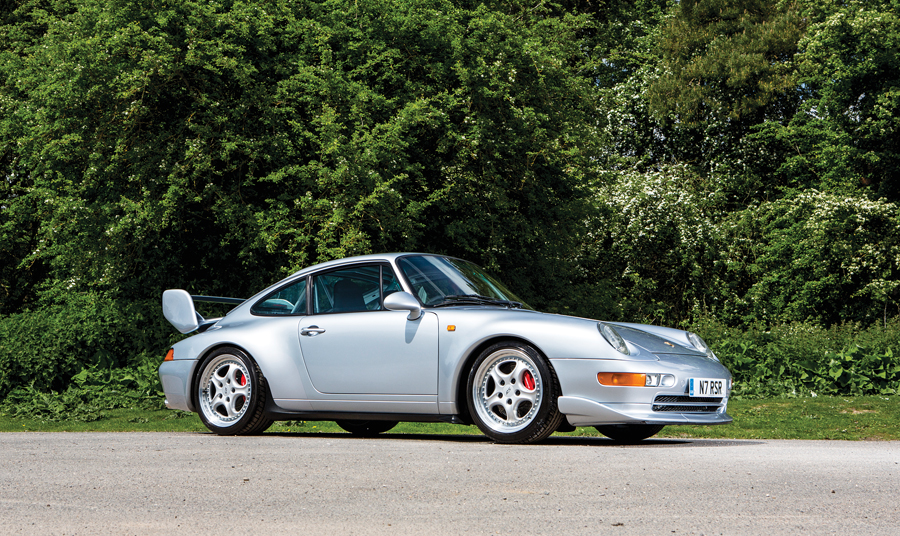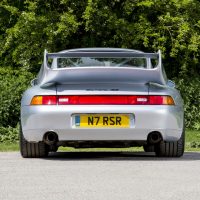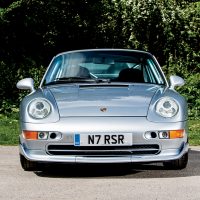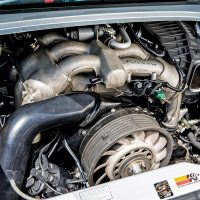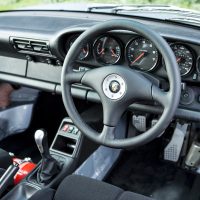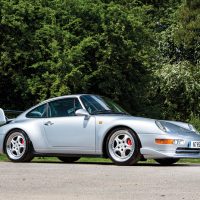- One of seven RHD examples
- Right-hand drive
- Full service history
- 23,667 miles from new
SCM Analysis
Detailing
| Vehicle: | 1996 Porsche 911 RS Clubsport coupe |
| Years Produced: | 1995 as 1996 model year |
| Number Produced: | 100 |
| Original List Price: | $117,000 |
| SCM Valuation: | Median to date, $275,347; high sale, $369,469 (this car) |
| Tune Up Cost: | Minor costs about $2,500 with spark plugs, filters and fluids. Major $5,000 adds wires and distributor (once in a lifetime, but needed after 20 years on original gear) |
| Chassis Number Location: | Base of windshield tag; stamping in trunk above spare tire; label on driver’s side inner front fender |
| Engine Number Location: | Vertical stand supporting engine fan |
| Club Info: | Porsche Club of America |
| Website: | http://www.pca.org |
| Alternatives: | 1997 Porsche 993 Turbo S; 1995 Dodge Viper RT/10; 1995 Corvette ZR-1 or 1996 Corvette Grand Sport |
| Investment Grade: | A |
This car, Lot 275, sold for £281,500 ($373,772), including buyer’s premium, at Bonhams’ Goodwood auction on June 24, 2016.
The 993 RS is a somewhat rare, desirable collector car — and an excellent, spirited driving car. The Clubsport took performance up a notch with further de-contenting and added rigidity from the welded-in full roll cage. Porsche built 1,014 993 RSs, of which 226 were Clubsports. Of course, many fewer were built in RHD, reportedly 126 RSs overall and just seven Clubsports.
RS cars are Porsche’s best street cars
All of us know that the 911 RS legend started in 1973.
Ignominiously, Porsche’s Sale Department decried the model, saying they could not sell the required 500 to homologate the RSR, especially since the U.S. market was off-limits due to governmental regulations. Ultimately, over 1,500 were sold, and the RS became a holy grail among Porschephiles, especially in North America, where it was forbidden fruit. Today, one of the 200 M471 Lightweights will set you back $1.2 million–$1.6 million. M472 Tourings range from $650,000 to over $1.1 million.
In 1974, a completely different RS was built, but in just 52 examples. It was a much more raw car, a virtual race car for the street. In Europe, many of the ’74 RSs were used in rallies and Group 3 races, making a complete, original-panels car very prized today. Currently, they run $1.4 million up to $1.8 million.
Along came the SC/RS
After a hiatus of 10 years, in 1984, Porsche built the SC/RS, its Group B rally car, 21 strong, with 10 going to rally teams. It is the most rare of all 911-based RSs. (The very rarest RS is the 1992–93 968 Turbo RS with four examples built. That one gives RS collectors fits.) A non-modified SC/RS is now well over $1 million, and some of the heavily modified team cars are as well, although much more difficult to sell.
None of the RSs of the 1970s and 1980s were imported and sold in the U.S., although many came in on the government’s 1980s “once in a lifetime” exemption. Today, with all early RSs well past 25 years old, they are imported freely.
The modern-era RS
Almost 10 years passed again before Porsche built another 911 RS. The 1992 964 RS was built in three variants, the Basic — aka Lightweight — the Touring, and the N/GT, a Group 3 and BPR race car. They were plentiful, with almost 2,300 produced: more than 1,900 Basics, 76 Tourings and 290 Group N/GT race cars. All 964 RSs are EPA-exempt now, and with production dates starting in the fall of 1991, all will hit 25 years of age in the next 12 months and will be able to enter the U.S. free of any federalization requirements. The 964 RS cars harken back to the 1974 RS cars; they are raw, somewhat primal — almost race cars for the street.
“Really raw and primal” describes the homologation base for the 964 RSR, the 1993 Carrera RS 3.8-liter. Built just 55 strong, with big flares, wide modular Speedline wheels, and big aero splitters and wings, the RS 3.8 has the looks and the guts to deliver on its nameplate. Because of the low production quantity and its iconic place in the RS pantheon, the RS 3.8 trades hands between $1.2 million and $1.6 million.
The 993 RS arrives as a 1996 model
Our best information is that Porsche made about 1,014 total 993 RS cars, of which 226 were Clubsports. That is not low production, but the model is very popular. It is a throwback to the 1973 RS, as it is more civilized than some RSs, not so raw, but very capable with an excellent power-to-weight ratio. It is much stronger on the street than its power numbers suggest; the factory 300-horsepower rating is sandbagged. I own a 993 RS in Speed Yellow, full Clubsport aero kit and a/c, all per the factory build sheet. I also have a 993 C2S. Driven back-to-back, the RS makes the C2S feel like you’re driving the living room. The torque from the additional 200 cc of displacement, uprated valve train, full seam welding, and 200 to 240 pounds lower weight translate into much more fun.
Our auction 993 RS Clubsport
Bonhams’ 993 RS was a conundrum. It was in a good color, Polar Silver. It had reasonably low mileage at 23,667. It was a U.K. home-market car, so perhaps a little less likely to have been to Nürburgring for 200 laps, as was the fate back in the day of most European-delivered Clubsports.
Was the RHD a deficit? Was the low-production Clubsport a valuable variant? How did the Brexit vote, which occurred literally the day before the auction, affect results?
Our read would be that RHD limits the market primarily to the U.K., as the additional RHD countries are far away. (Japan does not figure in, as they want their exotic cars only in LHD.)
I have imported and sold about 25 993 RS cars, probably about half of all the examples in the U.S. My experience is that the cars are prized as fine street cars, not track cars, and therefore, counter-intuitively, the more raw and raucous Clubsport is the lesser-desired model.
Enter Brexit
The auction house write-up made no mention of original paint, a key determinant of value on a 993 RS. Lastly, the Brexit vote had to throw a damper on everyone at Goodwood, as bidders woke up on auction day to learn of the surprising result.
In the U.S, we expect to see excellent 993 RS cars for $395,000–$450,000. Typically, they are in the same range in Europe. A repainted 42,000-mile RS sold at RM Sotheby’s Pinnacle sale at Monterey in August 2015 for $550,000, which was widely considered an anomaly. Gooding has one scheduled for Monterey in August 2016 estimated at $400,000–$500,000. In the past two years, several have been auctioned in Europe for $350,000–$450,000.
The hammer price at Bonhams was £250,000 (or about $328,500), definitely to the low side. The balance of £31,500 (or almost $49,000) represented Bonhams’ 15%/12% tiered buyer’s premium. The Bonhams RS sold under market. The RHD and the Brexit vote were the most likely culprits. ♦
(Introductory description courtesy of Bonhams.)
